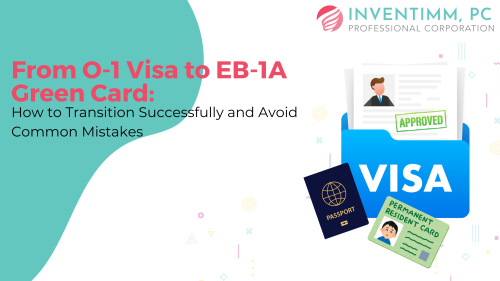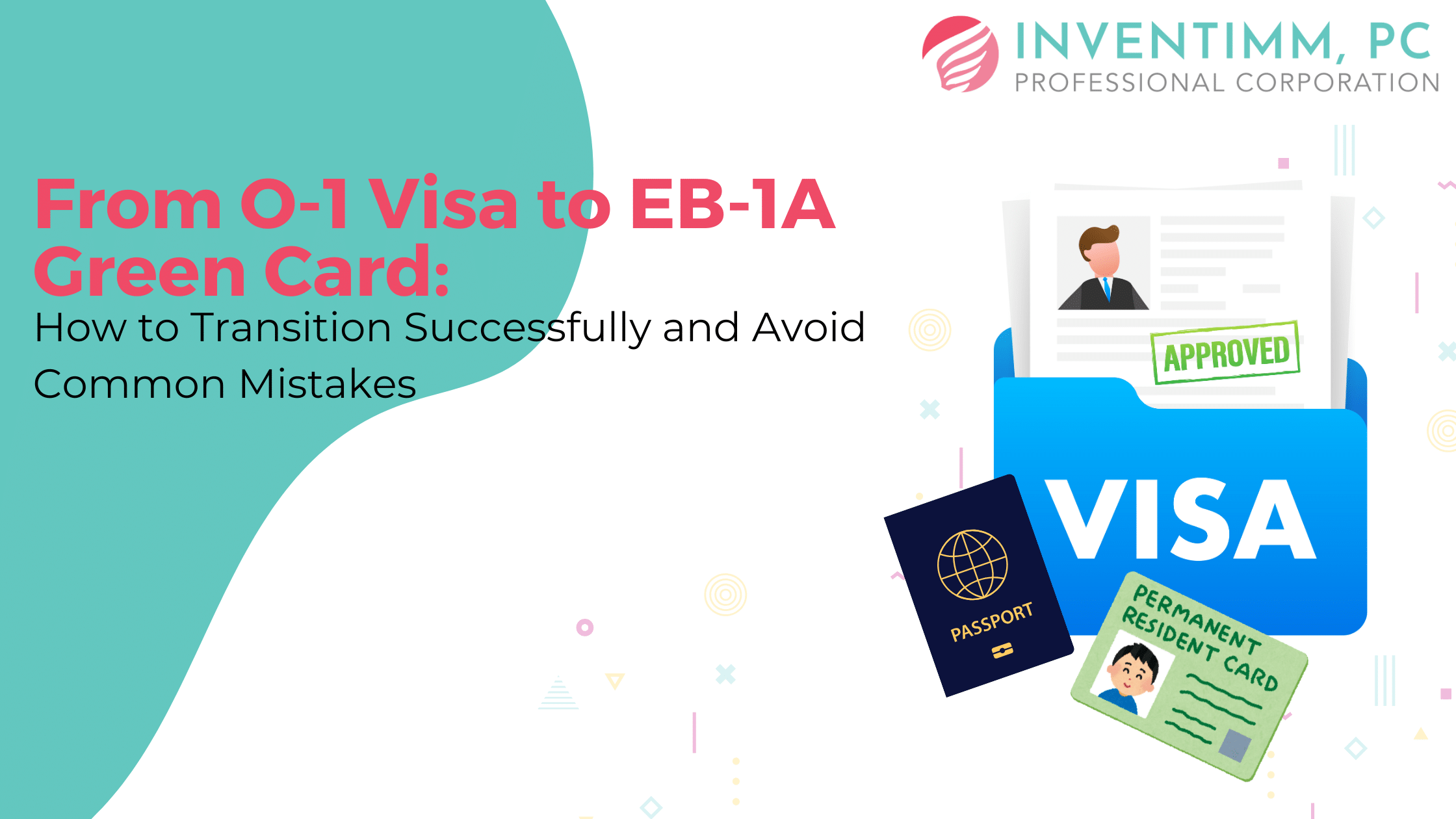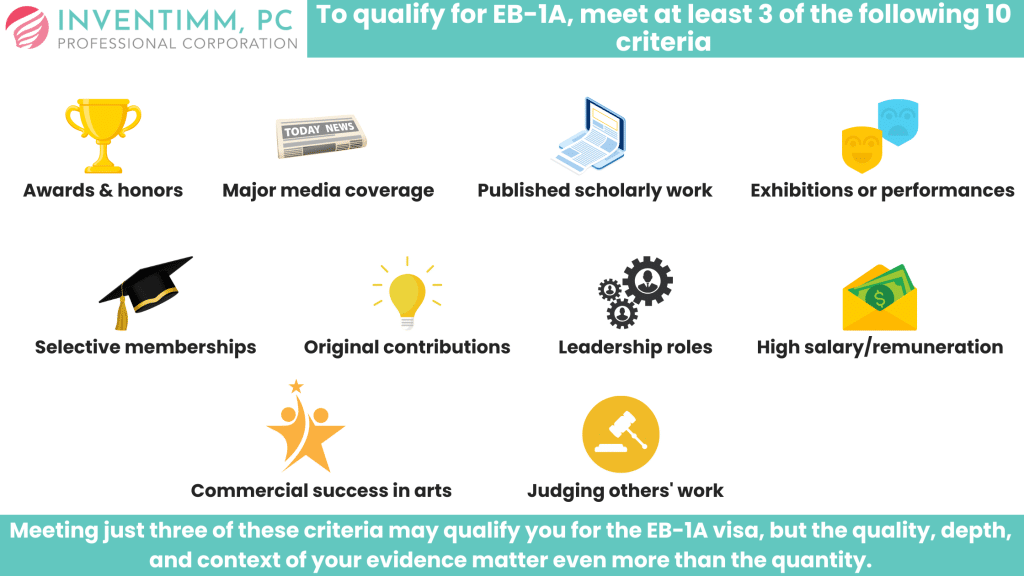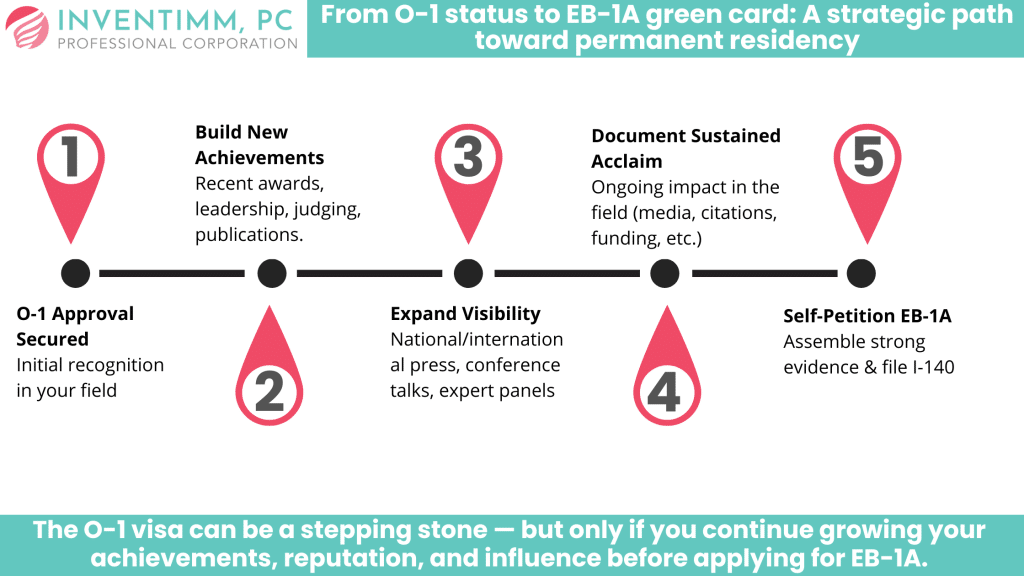Menu
From O-1 Visa to EB-1A Green Card: Successful Transition Tips
May 19th, 2025
Contributor: Rohit Srinivasa

1. Introduction
The allure of the EB-1A green card—often touted as one of the fastest ways to permanent residency in the United States for individuals who truly excel in their fields—can be very compelling. Many people who have already achieved notable success and secured an O-1A or O-1B non-immigrant visa find themselves asking, “Will my path to EB-1A now be straightforward?” The short answer is: not necessarily. An approved O-1A or O-1B can be a strong foundation, but it does not automatically guarantee that the United States Citizenship and Immigration Services (USCIS) will view you as meeting the higher bar set for EB-1A status. This blog explores why these two are not interchangeable, identifies the differences and unique requirements of each classification, and provides strategic steps you can take to ensure a smoother EB-1A application after receiving your O-1 visa.
This is not only a topic of academic interest or casual conversation—understanding the nuances can be critical to your future in the U.S. If you have an O-1A or O-1B and are considering transitioning to EB-1A, this detailed blog post will help you formulate an effective approach. We’ll also review illustrative scenarios to give you a real-world sense of how this process can play out, along with recommendations to position yourself for success.
2. Understanding the O-1 Categories (O-1A and O-1B)
2.1 What Is the O-1A Visa?
The O-1 visa category is designated for individuals with extraordinary ability or achievement. Specifically, the O-1A is for individuals who exhibit extraordinary ability in the sciences, arts (not including movies or television), education, business, or athletics. An O-1A visa holder is essentially someone who can demonstrate a level of acclaim that is recognized at a national or international level. The standard of “extraordinary ability” for the O-1A is often framed as being among the “small percentage” of individuals who have risen to the very top of their field.
To qualify for the O-1A, a candidate typically must provide documentation such as awards, publications, memberships in organizations that require outstanding achievements, or evidence of having been a judge of the work of others in the field. However, the standard is not as high as the EB-1A green card category, in part because the O-1A is only a temporary (non-immigrant) visa and is tied to a specific position or project in the U.S.
2.2 What Is the O-1B Visa?
The O-1B category is for individuals with extraordinary ability in the arts—including visual arts, performing arts, and design—as well as those with extraordinary achievement in the motion picture or television industries. Artists, musicians, dancers, actors, and others in creative fields typically apply under this classification. Like the O-1A, O-1B requires evidence of significant recognition in your area of expertise. For motion picture and television professionals, the evidence leans heavily toward distinguished recognition from major publications, reviews, or significant accolades in that sector.
The O-1B standard does allow for a bit more latitude in how you demonstrate your “extraordinary achievement,” especially for certain creative disciplines. Still, it remains a high bar and is reserved for people who can show that their skills and achievements place them in an elite category.
2.3 Common Uses for O-1 Visas
- Entertainment projects: Filming a movie, performing in a musical, or appearing on a major television production.
- Scientific research or academic pursuits: Researchers working on a high-level project at a university or a private research lab.
- Business or entrepreneurial roles: Founders, CEOs, or executives with a record of extraordinary success in their field.
- Cultural exchange and exhibitions: Artists holding unique exhibitions or performances in the United States.
The O-1 visa was designed to bring top international talents to the U.S. on a temporary basis, often for a specific job or project. Because it is non-immigrant, the O-1 is typically tied to an employer or sponsor, although it does allow for a U.S. agent to sponsor certain types of applications under specific scenarios.
3. Overview of the EB-1A Category
3.1 Who Is EB-1A For?
The EB-1A (Employment-Based First Preference) category is an immigrant petition for individuals of “extraordinary ability.” In other words, an EB-1A approval grants permanent residency (a green card). This classification is intended for those who have garnered “sustained national or international acclaim” and who are at the very top of their field. EB-1A covers a broad range of disciplines—sciences, arts, education, business, athletics, and more—very much like the O-1A visa. However, the central difference is that EB-1A is a path to a green card, not a temporary work visa.
3.2 The Criteria for EB-1A
USCIS has laid out regulatory criteria to determine if someone meets the EB-1A standards. You can qualify by either showing evidence of a major internationally recognized award (for example, an Oscar, a Nobel Prize, or a Pulitzer Prize) or satisfying at least three out of ten enumerated criteria, such as:
- Lesser nationally or internationally recognized prizes or awards.
- Membership in associations that demand outstanding achievement.
- Published material about you in professional or major trade publications.
- Evidence of original contributions of major significance in your field.
- Authorship of scholarly articles.
- Artistic exhibitions or showcases.
- Leading or critical role in distinguished organizations.
- High salary or remuneration compared to others in the field.
- Commercial successes in the performing arts.
Evidence of having judged the work of others in your field.
Beyond meeting the three (or more) criteria, you must also demonstrate sustained acclaim in your field—that means that your achievements are ongoing, recognized, and place you at a level of expertise and influence that sets you apart from the majority of your peers. Essentially, it’s not enough to have a flash-in-the-pan success; you have to show longevity or a pattern of excellence.
3.3 Advantages of EB-1A
- No Labor Certification Required: Unlike many other employment-based green card categories (such as EB-2 or EB-3), EB-1A does not require a labor certification (PERM). This can save significant time.
- Self-Petitioning: EB-1A allows for self-petition. You don’t necessarily need an employer to sponsor you, although having an employer can still be helpful in providing supporting evidence.
- Fast Processing: While this can vary, EB-1A petitions can be adjudicated relatively quickly compared to other employment-based immigrant categories, assuming all evidence is adequately presented.
4. Key Differences Between O-1 and EB-1A
4.1 Non-Immigrant vs. Immigrant Status
O-1 Visas
- Temporary (non-immigrant) classification.
- Tied to a specific employer, sponsor, or project.
- Can be extended in increments (up to three years initially, plus annual increments after that).
EB-1A
- Immigrant classification (green card).
- Offers permanent residency status if approved.
- Self-petition is possible, and there is no requirement for an employer sponsor.
Implication: Because EB-1A grants permanent residency, USCIS scrutinizes these petitions more thoroughly to ensure the individual genuinely qualifies at the highest levels of their field and will continue to excel in the U.S.
4.2 Level of Scrutiny and Evidence
While both O-1 and EB-1A require evidence of high achievement and acclaim, the EB-1A standard is notably higher because it results in a green card. An O-1 petition needs to demonstrate extraordinary ability for the term of the project or employment, but EB-1A requires demonstrating both extraordinary ability and sustained acclaim over time, along with the likelihood of continuing to benefit the United States in the future.
4.3 Role of the Petitioner and Self-Petitioning
- O-1: Typically requires a U.S. employer or agent to petition on your behalf. You cannot self-petition for an O-1, although you can potentially use a U.S. agent in certain situations where you have multiple or freelance/consulting engagements.
- EB-1A: Allows for self-petition. You can file for yourself, provided you meet all eligibility criteria. This is part of the reason EB-1A is appealing to many who wish to have more autonomy in their immigration journey.
5. Why an Approved O-1 (O-1A or O-1B) Does Not Automatically Guarantee EB-1A
5.1 Different Legal Standards
The crucial distinction lies in the legal threshold you must meet. While O-1 requires showing you have extraordinary ability or achievement for a temporary stay, EB-1A demands ongoing, major contributions and widespread recognition at a national or international level that justify granting you permanent residency. Think of O-1 as a high bar but EB-1A as an even higher, more rigorous standard that includes a layer of “sustained acclaim.”
5.2 Depth vs. Breadth of Achievements
An O-1 petition focuses on whether you meet the extraordinary ability criteria relevant to your field. For EB-1A, you need to demonstrate a broader scope of achievements or a higher degree of impact and influence on your field. It is not enough to merely restate that you have an award or a publication; you must show how that award or publication contributed significantly to your field’s body of knowledge or practice. Additionally, EB-1A typically looks for “continued” or “sustained” acclaim—how you have maintained and grown your presence in the field, not just a one-time milestone.
5.3 Changing Circumstances and Evidentiary Requirements
O-1 and EB-1A petitions are adjudicated at different times, often by different officers, and under separate eligibility criteria. The evidence that was once persuasive enough for O-1 may become outdated, incomplete, or insufficient for EB-1A. For instance, a major award from 10 years ago might help, but you should also show recent accomplishments—ongoing leadership, innovation, or recognition that continues up to the present.
Furthermore, a strong O-1 petition might emphasize a specific project or role. EB-1A, on the other hand, generally requires a broader perspective: how your entire career and set of contributions stack up compared to others at the top of your field. If USCIS believes your acclaim isn’t as “sustained” as required, or that you haven’t continued to achieve at the same level, an EB-1A could be denied even if you held O-1 status previously.
6. Building on Your O-1 Approval to Strengthen an EB-1A Petition
While O-1 approval isn’t an automatic EB-1A pass, it’s definitely a strong foundation upon which to build. If you’ve already secured O-1A or O-1B, you likely have the core credentials to make a competitive case for EB-1A with the right additional evidence and strategy.
6.1 Expanding Your Portfolio of Evidence
Go beyond the “bare minimum.” If you barely met the O-1 criteria, you’ll need to shore up your case for EB-1A. Collect additional awards, proof of judging or mentoring, higher-profile media coverage, or any other new accomplishments. If you gave important keynote presentations or performed at prestigious venues, gather that evidence. If you’ve authored new publications, updated your Google Scholar citations, or received a new research grant or contract, document it meticulously.
6.2 Continuous Recognition and Updating Achievements
Remember that EB-1A emphasizes “sustained” acclaim. To show that your achievements are ongoing, maintain an archive of all new articles about you, any continuing coverage, or new invitations to prestigious events. The key is to demonstrate that you did not peak years ago but are still relevant and recognized as a leading figure in your field.
6.3 Proactive Approach: Networking and Thought Leadership
Constantly look for opportunities that increase your visibility and reputation in your industry:
- Speak at conferences: Even short presentations, if they are at reputable venues, can help build your case.
- Contribute to professional journals or publications: Publish articles, editorials, or expert opinions.
- Media appearances: If you’re an expert in a hot topic, local or national media might be interested in your perspective.
- Professional memberships and leadership roles: Take on official titles or responsibilities that help you stand out.
These activities not only elevate your professional profile but also supply you with the type of documentary evidence USCIS looks for when determining if you’re truly among the top talents.
6.4 Documenting Your Influence in the Field
One of the trickiest parts of an EB-1A petition is showing the impact of your work. Winning an award is one thing—demonstrating how that award influenced or transformed your industry is another. If you are an entrepreneur, provide testimonials from high-level professionals or evidence of significant venture capital investment, acquisitions, or intellectual property success. If you are a scientist, highlight citations, references, or practical applications of your research. If you are an artist, emphasize how your work has contributed to new trends or garnered critical acclaim from recognized authorities in your field.
By translating your accomplishments into tangible, quantifiable measures of impact, you make a stronger case that you stand at the pinnacle of your discipline.
7. Hypothetical Examples and Case Studies
Below are some generalized, hypothetical scenarios to illustrate how an individual on O-1 status might evolve their portfolio to meet EB-1A requirements. These examples are for educational purposes only.
7.1 The Acclaimed Research Scientist (O-1A to EB-1A)
Scenario: Dr. Martinez is a research biologist who came to the U.S. under O-1A status to work on a cutting-edge genomics project at a top-tier university. She has peer-reviewed publications and a few lesser-known awards in her field.
- O-1A Evidence: Publications in recognized journals, a national-level award for young researchers, membership in a scientific society that admits only accomplished professionals.
- Gap for EB-1A: Needs sustained recognition, more citations in major publications, or demonstration of a broader impact.
Building a Strong EB-1A Case:
- Continue publishing research, ideally in higher-impact journals.
- Collect citation data to show increasing influence of her work.
- Seek opportunities to serve on editorial boards or be an invited speaker at international conferences.
- Document any media coverage or major press releases about her groundbreaking research.
By showing the growth and expanded impact of her research, Dr. Martinez can demonstrate that her acclaim is ongoing and widespread enough for the EB-1A classification.
7.2 The Performing Artist (O-1B to EB-1A)
Scenario: Ms. Davis is a contemporary dancer who came to the U.S. on an O-1B to perform in a world-renowned dance company. She has performed in multiple high-profile shows and received strong reviews in niche art publications.
- O-1B Evidence: Documented performances in prestigious venues, recognition by local critics, a notable international dance award in a regional competition.
- Gap for EB-1A: Not enough mainstream or national/international press, lack of evidence of ongoing recognition beyond her performances.
Building a Strong EB-1A Case:
- Secure interviews or features in major dance or performing arts magazines.
- Choreograph her own pieces or collaborate on projects that garner critical acclaim.
- Judge or mentor in dance competitions or educational programs.
- Demonstrate the commercial success and artistic innovation of her performances (e.g., box office numbers, wide critical acclaim, or major sponsorships).
Over time, Ms. Davis can develop the kind of record that satisfies EB-1A’s requirement for sustained acclaim and significant contributions to the performing arts field.
7.3 The Rising Tech Entrepreneur (O-1A to EB-1A)
Scenario: Mr. Kim is a technology entrepreneur who was granted O-1A for his role as a founder of a startup recognized for pioneering artificial intelligence software for finance. He has some media coverage and has raised venture capital funds.
- O-1A Evidence: A few press articles, moderate VC funding, membership in an exclusive entrepreneurs’ association.
- Gap for EB-1A: Needs to show a greater degree of national or international impact, high-level recognition (awards, major press), and sustained leadership in the field.
Building a Strong EB-1A Case:
- Expand the scope of his company’s success—higher revenue or transformative partnerships.
- Win or be nominated for industry awards that highlight innovation.
- Speak at major tech conferences or serve as a mentor or judge for startup competitions.
- Establish that his influence extends beyond his startup to the larger tech community, such as advisory roles, boards, or significant patent contributions.
By demonstrating his leadership and the broader impact of his technological innovations, Mr. Kim can position himself for an EB-1A petition that underscores both his personal achievements and how they benefit the field at large.
8. Common Pitfalls and How to Avoid Them
8.1 Relying Solely on O-1 Credentials
A key mistake is submitting basically the same documentation that was used for the O-1 petition. While some of that evidence is relevant, EB-1A requires more rigorous proof of ongoing achievements. Always update your portfolio and include new accomplishments.
8.2 Failing to Update or Strengthen Evidence
What was cutting-edge five years ago might be routine today. If you haven’t made new contributions or grown your professional profile, USCIS may see your accomplishments as static. Regularly document fresh achievements, media recognition, and professional activities.
8.3 Overlooking the Self-Petition Process
A misconception many O-1 visa holders have is that transitioning from O-1 to EB-1A must be employer-driven. While an employer can support your petition, EB-1A actually allows self-petition. You have more agency in the EB-1A process, but that also means you have to be proactive about assembling a robust case.
8.4 Insufficient Explanation of Sustained National or International Acclaim
USCIS officers often look for detailed explanations connecting the dots between your evidence and how it demonstrates “extraordinary ability.” Don’t just list awards or articles—explain their significance. Why is this award prestigious? Who judges it? How large is the competition? How does your recognition compare to others in your field?
9. Practical Steps to Prepare for an EB-1A After O-1
Below is a structured approach you can follow once you decide to pursue EB-1A. These steps will help ensure you cover all your bases and present the strongest case possible.
9.1 Gather Documentation Early
Start collecting and organizing your documentary evidence well ahead of filing. This includes:
- Awards, nominations, and certificates: Keep the original documents where possible, along with any official letters or announcements.
- Media coverage: Archive print and online articles, reviews, interviews, and news segments.
- Evidence of judging or review: If you have acted as a judge in competitions, keep official invitations and results.
- Letters of membership: For prestigious societies, keep records of membership criteria.
- Performance or project invitations: If you’re an artist or performer, detailed invitations or programs from prestigious events are important.
9.2 Engage Reputable Experts for Letters of Recommendation
Strong letters from recognized experts in your field can be pivotal. Pick experts whose names carry weight and can attest to your extraordinary skill and impact. These letters should:
- Establish the credibility of the recommender (e.g., their background, awards, major accomplishments).
- Explain how they know you and your work.
- Cite specific examples of how your contributions or talents are extraordinary.
- Discuss the significance of your accomplishments within the broader context of your field.
9.3 Keep Detailed Records of New Accomplishments
Every time you achieve something noteworthy, add it to your personal “EB-1A file.” Keep track of:
- Invitations to speak at major conferences.
- New articles featuring or authored by you.
- Additional awards or honors.
- Leadership roles, editorial board memberships, or peer-review activities.
By consistently updating your record, you’ll have a much easier time preparing a thorough EB-1A petition.
9.4 Seek Experienced Legal Advice
Because immigration law is intricate and the EB-1A standard is very high, it’s wise to consult with an experienced immigration attorney early on. They can guide you through the criteria you meet, how to address any gaps, and what additional evidence might be needed. While EB-1A allows self-petitioning, having professional guidance can make a big difference in presenting a compelling narrative that meets (and exceeds) USCIS requirements.
10. FAQs - Transitioning from O-1 to EB-1A
Q1: Does having an approved O-1 visa guarantee EB-1A approval?
A: No. While an O-1 visa shows you meet a high standard of achievement, EB-1A requires a higher threshold of sustained acclaim and broader recognition. Each petition is reviewed independently.
Q2: Can I self-petition for EB-1A even if my O-1 was employer-sponsored?
A: Yes. EB-1A allows for self-petitioning, meaning you don’t need an employer to file on your behalf. You can apply independently if you meet the criteria.
Q3: How soon after getting an O-1 can I apply for EB-1A?
A: There’s no mandatory waiting period, but it’s important to build and document additional achievements, especially if your O-1 was approved based on a limited scope of work.
Q4: What kind of new evidence should I gather before applying for EB-1A?
A: Focus on recent awards, publications, media coverage, leadership roles, judging activities, and proof of continued influence in your field. USCIS wants to see your impact is ongoing.
Q5: What are the most common reasons for EB-1A denials after O-1?
A: Reusing outdated evidence, lack of sustained national/international acclaim, weak documentation, or failure to clearly explain the significance of your accomplishments.
11. Conclusion
Securing an O-1A or O-1B visa is certainly an excellent milestone and an indication that you are recognized for your extraordinary achievements in your field. However, the EB-1A green card category requires a more stringent demonstration of sustained national or international acclaim and ongoing influence. There are important legal, procedural, and evidentiary differences between the two categories, and while an approved O-1 can lay the groundwork, it is not an automatic ticket to EB-1A.
If you aim to transition from O-1 to EB-1A, you should focus on continually building your profile: accumulate updated evidence of achievements, expand your industry influence, take on roles that highlight your leadership, and document your ongoing impact in your field. By taking a proactive, systematic approach—such as gathering detailed evidence, enlisting strong recommendation letters, and staying abreast of new opportunities to shine—you bolster your case significantly.
Remember that EB-1A is an immigrant classification, offering the benefits of permanent residency in the United States. With those benefits come a higher burden of proof that requires thoughtful preparation. If you plan to undertake this journey, consult with an immigration attorney experienced in EB-1A petitions to tailor your approach and strategize the strongest possible application.
In essence, an O-1 visa can be an excellent stepping stone on the path to EB-1A, but you must demonstrate that your acclaim is indeed of the caliber and duration that the EB-1A category requires. By systematically documenting your successes and continuing to achieve at a high level, you significantly enhance your chances of convincing USCIS that you belong among the top professionals in your field who merit permanent residence in the United States.
Disclaimer: This blog is meant for educational purposes only and does not constitute legal advice. Immigration regulations are subject to change, and individual circumstances vary. For personalized guidance, consult with a qualified immigration attorney.
Categories: U.S. Immigration
© 2025 INVENTIMM, PC
Legal Disclaimer | Privacy Policy
Law Firm Website Design by The Modern Firm





